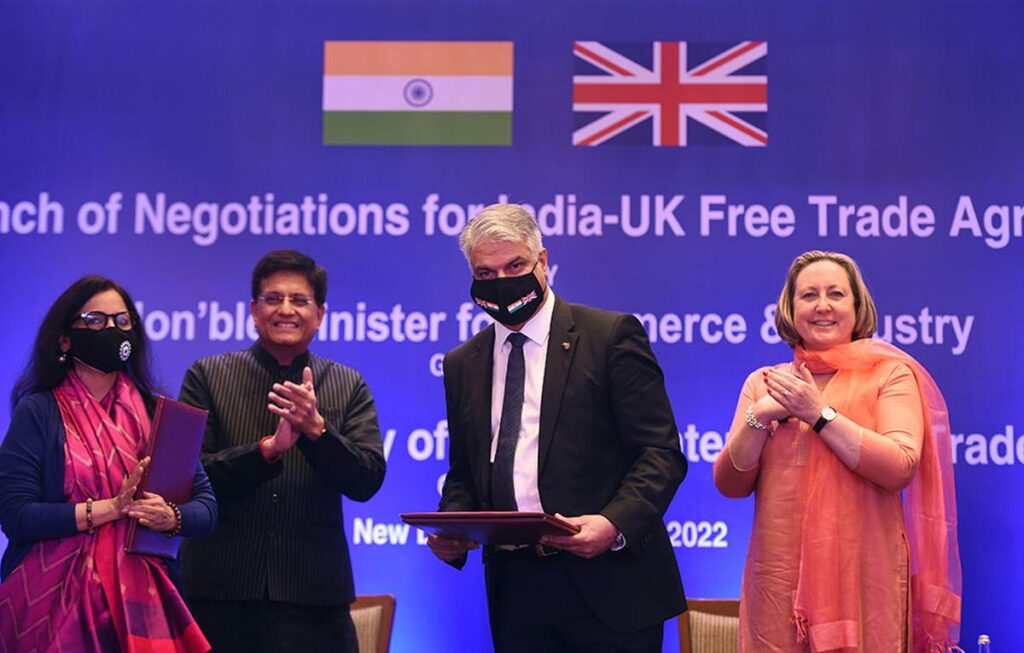
Introduction
The widely discussed India-UK Free Trade Deal has missed its Diwali deadline. The deal, being an ambitious one, aims to cover more than 90 per cent of the tariff lines and between both the countries. For India, this deal is another manifestation of its newly resuscitated fervour for trade deals, after almost a decade’s hibernation. For the UK, the imminent FTA is another step forward in its post-Brexit trade policy. The deal holds a special position in the foreign policy of both the countries as signified by the India-UK Comprehensive Strategic Partnership and India-UK roadmap 2030. The discussions around the deal and the deal’s proposed content have to be analysed in the context of the juncture the global order is at. There are signs of another global recession in 2023 caused by the war of Ukraine and the following food and energy crisis. Now that the fulcrum of International trade has shifted to the Indo-Pacific, a contextual analysis of the UK-Trade deal as a paradigm of modern trade deals is required. This piece aims to do the same.
Uncertainties Unbound
With the advent of COVID, November 2019 marked the beginning of a different era. This era is characterised by uncertainty and distrust. Free trade was on a free fall even before COVID arrived, with conservative protectionist administrations in the major world economies. Protectionist tendencies peaked during COVID, completely disrupting supply chains all over the world. This led to soaring inflation and unemployment in economies across nations. Even with the shadow of the Virus remaining, global order is still infected with the seemingly ever-present uncertainty and crisis. The Russia-Ukraine conflict has created an energy crisis in Europe and led to soaring food prices all over the world. Over this, Floods in Pakistan and heatwaves in Europe are a reminder of the increasing danger of climate change. 2023 is set up to have a rocky beginning, to say the least.Meanwhile, Indo-Pacific has become the theatre of economic power dynamics and a harbinger of free trade. The Indo-Pacific constitutes more than two third of the global GDP and more than 50% of the trade merchandise flows through its waters. As accepted by major world leaders an open and free Indo-Pacific is essential for a prosperous world in the 21st Century. China’s
increasing dominance in the region threatens the promise of Indo-Pacific. It is in this context, the leaders of India and the UK find their place in the world order.
India and the UK in the Permacrisis
Britain formally left the European Union in 2021 with the goal of creating a ‘global Britain’. It is evident that the path has not been smooth. The country has a lot of work to do to concretise the ‘rolled over’ trade deals it has with 33 countries. On top of that the conservative leadership has been roiled with political instability. The unfunded tax cuts are
going to hurt Britain in the upcoming economic winter. The deal will unlock this huge market with the potential to boost bilateral trade by up to GBP 28 billion a year by 2035. A successful trade agreement with India in the form of FTA is a crucial step in UK’s Indo-Pacific tilt and post-brexit strategy.
India has a better opportunity to grow in the upcoming year fueled with subsidised energy from Russia. India’s revived enthusiasm for free trade agreements, after backing out of the RCEP, is visible in the deals it signed with UAE and Australia. Signals are clear that India is looking to make the most out of the FTA with the UK.
The ‘new age’ FTA
The promise of the new Free Trade Agreement lies in the bases it covers. The problems mentioned above have been discussed in the FTA. Although not much has been said about the content of the deal, leaders have introduced it as a ‘new age FTA’. What does this mean? It goes beyond the orthodox boundaries of goods, services and investments. They cover subjects such as labour, climate change, intellectual property, supply chains, e-commerce, digital technology, data protection and other evolving sectors. This deal includes these subjects while avoiding the sensitive topics for both the countries.
The deal under the 2030 India-UK roadmap targets to double the trade between both the countries by 2030. As the deal will cover more than 90% of the goods, producers from both the countries will have access to lucrative markets. Industries such as leather, textile and steel will benefit from the reduced duties. Removing duties as agreed in the agreement would increase UK export to India by GBP 6.8 billion. There is also great potential for increasing exports in service sectors like IT/ITES, Nursing, education, healthcare, including AYUSH and audio-visual services. It has been advised by the experts that India being a tech giant and in the area of start-ups could enable the new/mid-sized companies to have access to the U.K. market. The UK on the other hand will have coverage in the Indo-Pacific region. India’s prominent presence in the drive for sustainable energy, especially solar energy, will help UK in fulfilling its energy needs in the long term.
However, the picture is not all rosy. India has not benefited a lot from its previous FTAs. There can be increased job outsourcing, poor working conditions and degradation of natural resources. Also, FTAs have traditionally benefited only the big players in the market. The MSMEs, small farmers and middle to low-skilled workers have taken a hit because of the more competitive prices because of reduced tariffs. Taking binding commitments on new issues like environment, labour and sustainability in the proposed FTA, being negotiated by India, may hamper the country’s exports in the future. UK, being a developed country may push for unachievable climate targets for India, which is inconsistent with the goal of achieving adequate growth. From the UK’s perspective, India may not be a ditto alternative to China, because labour laws are not as easy to bend in India. These issues are essential to be resolved, otherwise the deal won’t be fruitful for anyone.
Conclusion
The India-UK trade agreement is set to bring a sea change in the relationship of both the countries. The potential of the agreement to go beyond the traditional boundaries to cover issues such as environment, digital technologies and labour make it a type ideally suited for these times. Rishi Sunak, the British PM of susceptibly Indian origins, mentioned the deal in his first foreign policy speech, displaying how the progress on the deal won’t stop regardless of the administration change. Despite the apprehensions around free-trade agreements, India has been constantly working for the fruition of this deal.
The camaraderie of India and the UK is demonstrated in their collaboration during the peak of the pandemic to produce a vaccine which has been used to inoculate majority of people in both countries. Trust has not been a normal for quite some time in the international sphere. No matter how the deal turns out to be, it won’t be untrue to say that India and the UK have challenged the normal by signing this deal.




